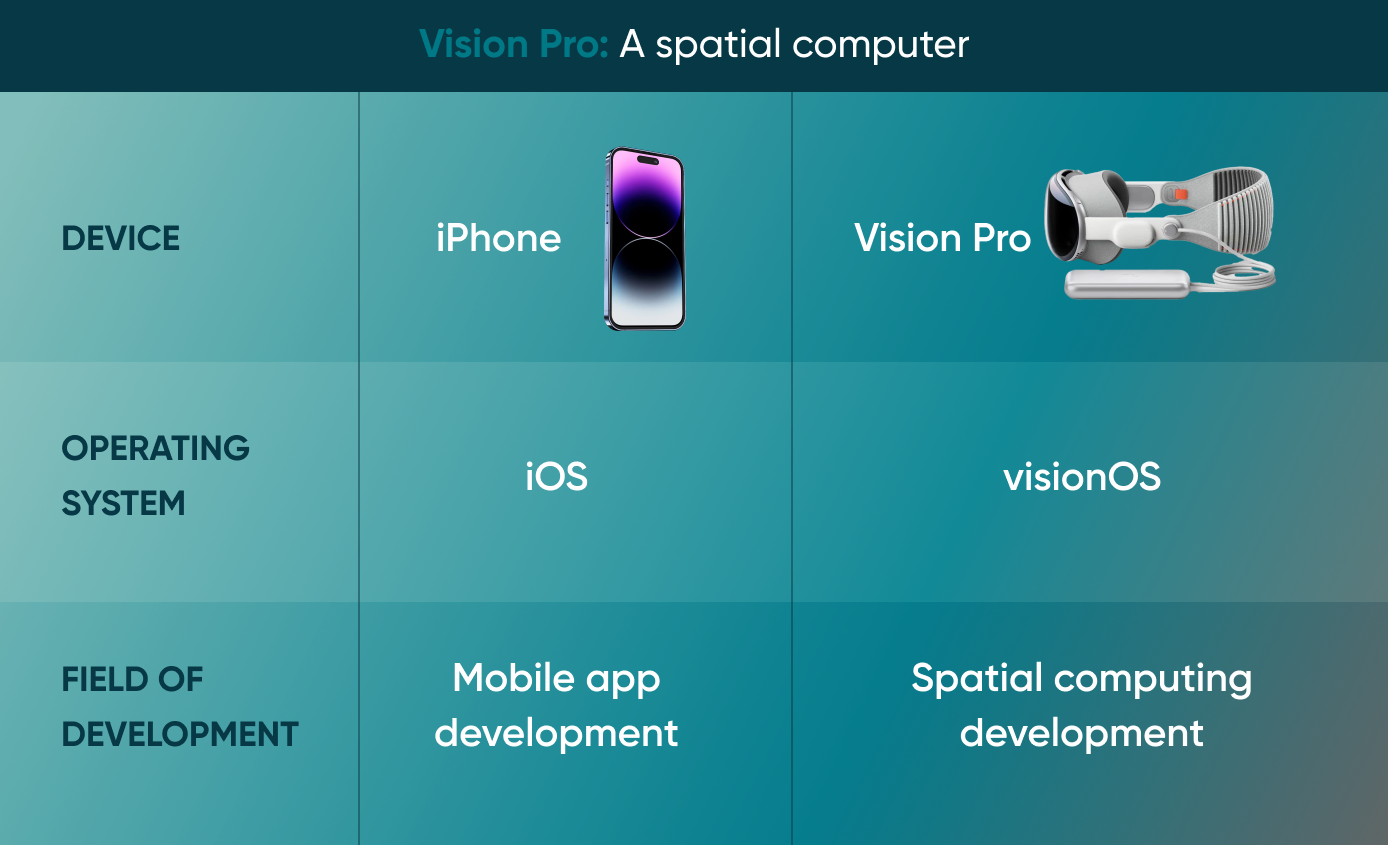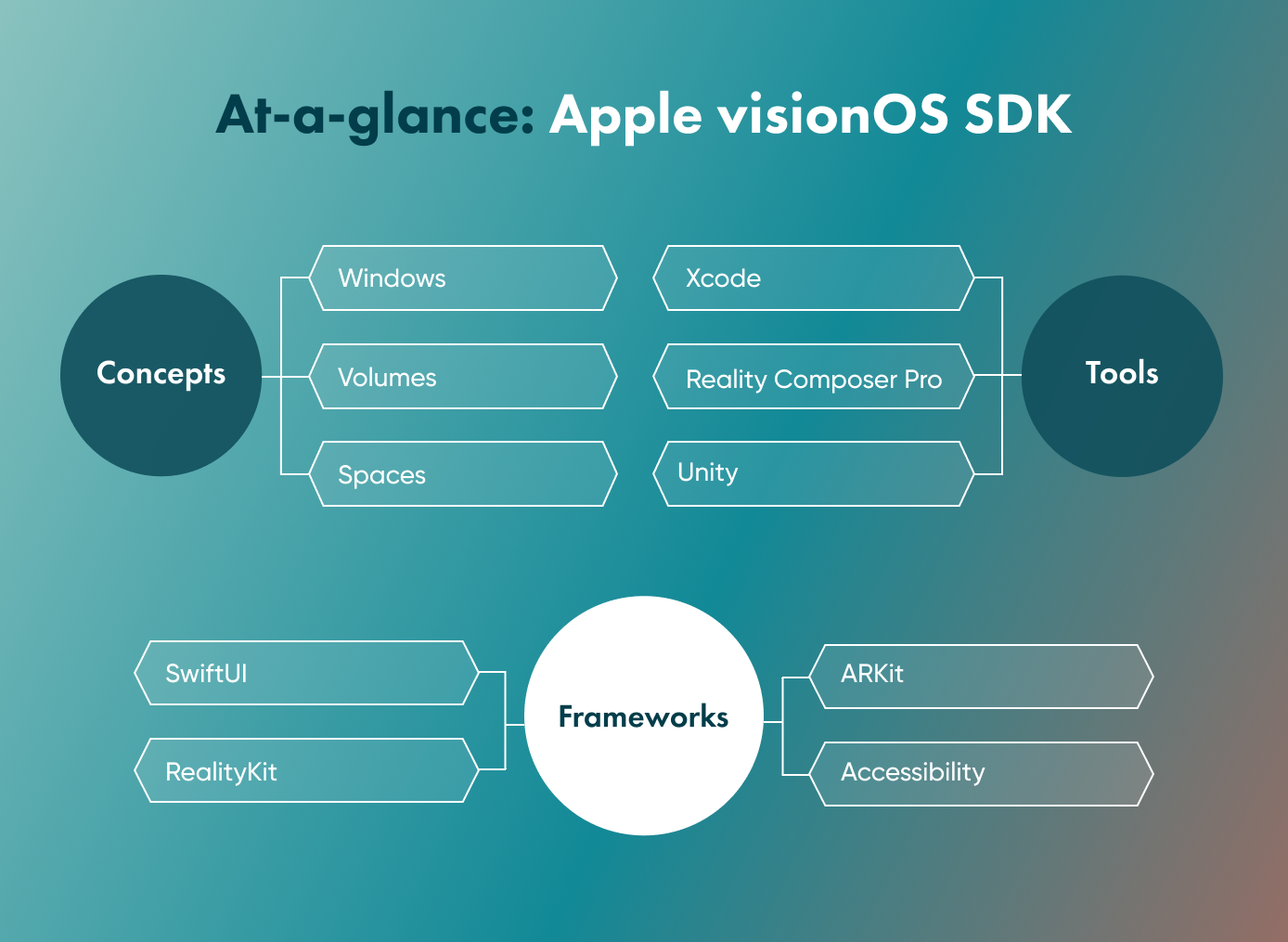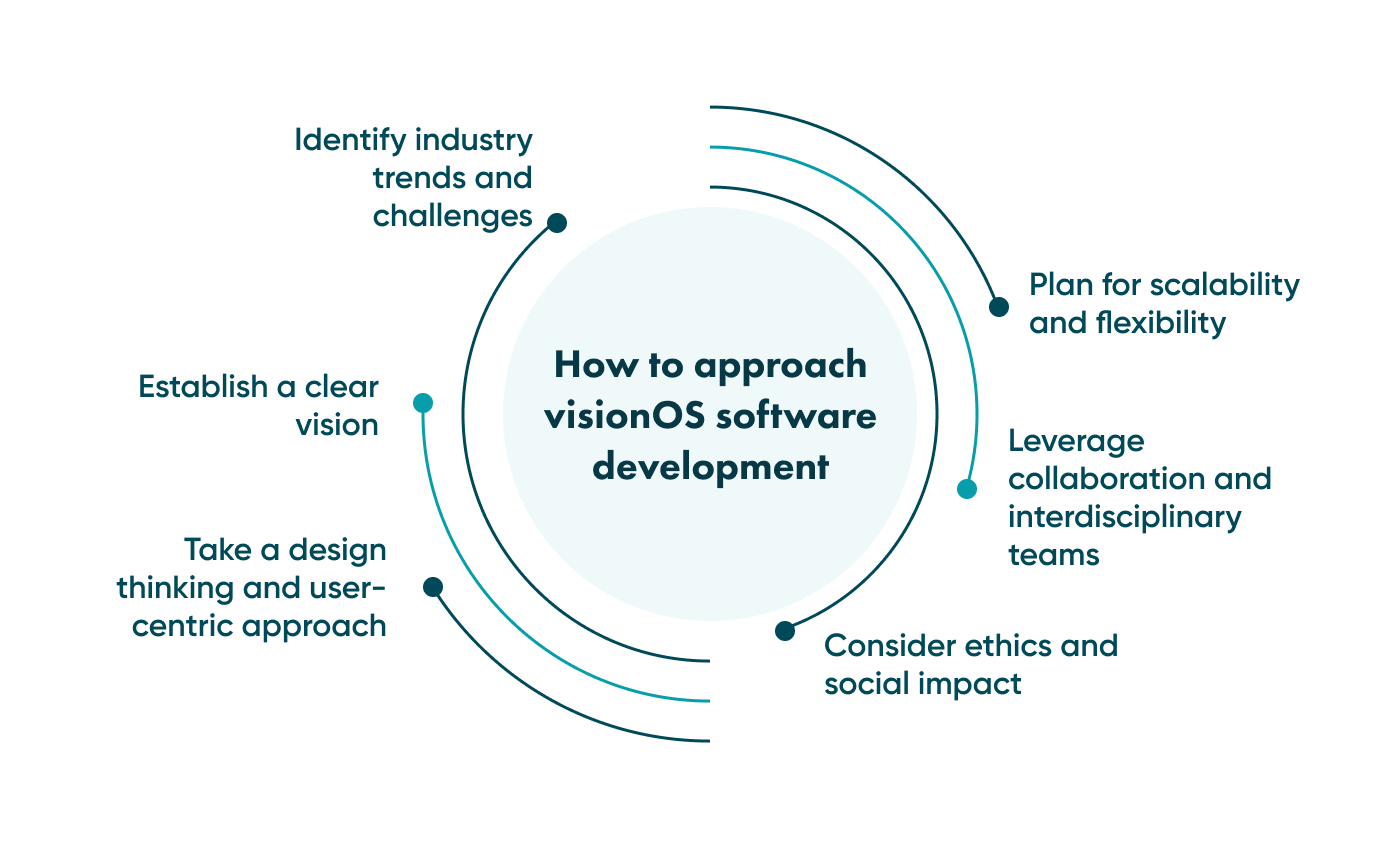VisionOS Software Development: Building Innovative Solutions for the Future


All signs point to spatial computing as the next field to reshape software development. Leading the charge will be Apple’s Vision Pro, powered by their visionOS. Here, we will delve into the world of visionOS software development, exploring the basics and listing some best practices.
In this brief guide, we will:
- Help you understand what the Apple Vision Pro and visionOS are.
- Give you some context about the field of spatial computing.
- Highlight the building blocks of visionOS software development
- Provide pointers for how to approach visionOS software development
Vision Pro and visionOS: An introduction
As Apple is pretty good at making a splash when it comes to marketing, you've probably heard of the launch of their Vision Pro. They look like VR goggles, but, in true Apple fashion, they take them to the next level when it comes to style and spatial computing capabilities.
What is Apple Vision Pro?
Speaking of spatial computing, that's basically what the Apple Vision Pro is: a spatial computer. It differs from other VR headsets in that it doesn’t have to be tethered to a phone or other computer.
What is visionOS?
VisionOS is the operating system behind this particular spatial computer. Built on the foundation of other Apple OSes, it has the capability of controlling the Apple Vision Pro with hand gestures, eyes, and voice.
Yes, other spatial computing headsets have existed before, but visionOS takes interaction design to a new level, making it feel more natural and immersive for users as they use their hands, eyes and voice to control and experience it.
Content in visionOS is volumetric and spatial, enhancing the user experience. Apps will have spatial depth and be moveable, resizeable, and adaptable to real-world lighting environments.
Unlike the background on your current display, you will be able to transform your environment into something that feels like you're part of a beautiful landscape or other immersive environment.
And you won't necessarily be isolated: with EyeSight technology you can enjoy seamless collaboration with those around you.
Spatial computing: A new realm
Before we get deeper into visionOS development, let’s zoom out for context and touch on the realm of spatial computing. Here’s an analogy to help us put it in perspective: as the iPhone is to iOS and iOS is to mobile app development, the Vision Pro is to visionOS and visionOS is to spatial computing development.

Enter the next dimension with spatial computing
In the world of visionOS, spatial computing is the bridge to the next dimension. It fuses the physical world with the digital world, overlaying information and allowing users to interact with it through hand gestures, voice commands, and more. Spatial computing relies on sensors, cameras, and tracking technologies to create a 3D user interface.
The Apple Vision Pro and visionOS are leading the charge in spatial computing. This revolutionary device allows users to see the real world while adding layers of information and interactivity on top of it. It's more than just virtual reality; it's mixed reality (MR) at its finest.
Building the ‘mirrorworld’
Kevin Kelly, a prominent tech thinker, refers to the concept of a ‘mirrorworld’ in the context of spatial computing. Smartphones took the world by storm, but now we're moving beyond them. The mirrorworld is a world that exists parallel to our own, accessible through spatial computing devices like the Apple Vision Pro.
To fully embrace the mirrorworld, you'll need spatial computing glasses. These glasses will require high-bandwidth connections to function optimally. There's a lot of room for development in this space especially in terms of data compression in order to make the experience more seamless.
Spatial audio: right there, always on
In the realm of spatial computing, audio plays a vital role. Spatial audio, as the name suggests, allows you to hear things with a depth of space. As Kelly says, it will feel ‘right there’ and always on. It provides users with a sense of direction, like a personal assistant guiding them through the digital world. It also enables users to listen in foreign languages, making communication more accessible.
Spatial audio in visionOS enriches the immersive experience, allowing users to feel more connected to the digital content and information. It's yet another dimension of interactivity that visionOS brings to the table.
AI: The silent force behind visionOS
Artificial intelligence (AI) is the silent force driving visionOS and the mirrorworld. To make the mirrorworld a reality, we need AI that can map and parse everything we see seamlessly. Unlike the visible user interface, AI operates behind the scenes, constantly analysing data and making real-time decisions.
This ongoing, constant AI is similar to the technology used in self-driving cars but will be applied to us and our interactions as we navigate the mirrorworld of spatial computing with devices like the Vision Pro.
It will also require computer vision software development to be able to scan and process images and videos for data.
Go Wombat already has experience with custom computer vision development services. Take a look at one of our related case studies.
The building blocks of visionOS development
Ready to start creating for this merging of the real and digital worlds? Let’s dive in and see how developing for visionOS is going to work.
The concepts
Here are some of the basic concepts that differentiate visionOS development (and spatial computing in general) from previous types of software development.
- Windows - built with Swift UI, with traditional views and controls, but with 3D content added. And speaking of 3D content, you also have…
- Volumes - SwiftUI scenes with 3D content, created with RealityKit or Unity and viewable from…
- Spaces - windows and volumes can be used to show content in…
-
- Shared Space - the default once an app is launched, similar to multiple apps on a desktop. Or the content can be shown in...
- Full Space - which once opened, shows only that app's content for an immersive experience.
The frameworks
The following frameworks are available as part of Apple’s software development kit (SDK):
- SwiftUI - the base for creating apps for the Vision Pro
- RealityKit - Apple's engine for 3D rendering, integrated with the above (also referred to as a 'renderer')
- ARKit - for blending the real world with content, able to understand surroundings
- Accessibility - for using eyes, voice, or a combination of both to interact with the device
The tools
Developers are already re-imagining their apps for the "infinite canvas" that visionOS provides.
Here are some tools that enable this:
-
Xcode - starting point for development, previews for iterations, allows tests and visualisations
-
Reality Composer Pro - integrated with Xcode, helps you prepare your 3D assets and preview them
-
Unity - create new apps or port existing ones onto visionOS with its familiar yet potent authoring tools

How to approach visionOS software development
More than just hard coding, there are some things developers and businesses should take into account in order to lay the groundwork for a successful Vision Pro software application.
Identify industry trends and challenges
In the world of visionOS software development, staying ahead of the curve is not an option – it's a necessity. By keeping a finger on the pulse of technological advancements, market shifts, and customer demands, VisionOS developers are poised to anticipate future needs and design groundbreaking solutions.
Here are 2 keys to this pursuit:
- Conduct thorough market research
- Make data-driven decisions
Establish a clear vision
Developers should compose a vision statement to use as a compass to guide their visionOS software development. It's not enough to create software – it's about understanding its purpose, mission, and desired outcomes. A strong alignment with business objectives and customer expectations is essential for driving innovation and success.
Take a design thinking and user-centric approach
User-centricity is at the core of visionOS software development. Design thinking, combined with a deep understanding of user needs and behaviours, leads to the creation of intuitive, engaging, and impactful solutions.
In this context, users are active participants in the development process, providing valuable insights through:
- User research - Developers aim to understand user needs, pain points, and behaviours to inform their design.
- Prototyping - Developers create and refine solutions based on user feedback, ensuring a user-friendly experience.
Plan for scalability and flexibility
VisionOS software development anticipates growth. Solutions must be scalable, adaptable to evolving requirements, and capable of handling increasing user demands.
Here's how visionOS accommodates scalability and flexibility:
- Microservices architecture - For some applications, visionOS often employs a backend with microservice architecture, allowing different parts of the application to scale independently.
- Scalable infrastructure - VisionOS projects are built on scalable infrastructure that can grow with the demands of the user base.
- Cloud computing - The cloud is a fundamental component of VisionOS. It provides the flexibility and scalability needed for modern software solutions.
- Adaptability - VisionOS solutions are designed to adapt to evolving requirements, ensuring they remain relevant and effective.
Leverage collaboration and interdisciplinary teams
Like any project, developing for visionOS thrives on collaboration and interdisciplinary teams. Diverse perspectives, skills, and expertise foster creativity, problem-solving, and innovation. Cross-functional collaboration between developers, designers, product managers, and domain experts is the lifeblood of visionOS software development.
Consider ethics and social impact
In the era of visionOS, ethical considerations and social impact take centre stage. Developers bear the responsibility of prioritising privacy, security, and inclusivity in their solutions. VisionOS software development has the potential to address societal challenges and contribute positively to communities and environments.

Unlock Success with Premium Software Development
Contact us


Final thoughts: visionOS software development
In summary, we’ve touched upon the basics of Apple’s Vision Pro device and its operating system visionOS as well as explored the building blocks and approaches to visionOS software development.
The convergence of spatial computing and visionOS presents exciting opportunities for digital transformation for businesses across various industries. Not only can businesses present immersive experiences to their customers, but also they can leverage them to optimise processes such as training, assessing performance, and repairing equipment from a distance. From manufacturing to logistics, property management to construction management, and even autonomous vehicles, spatial computing systems like visionOS offer a whole new dimension of possibilities.
With the launch of software development kits, developers can now harness the capabilities of Vision Pro to create innovative solutions. As visionOS continues to gain momentum, businesses will recognise the transformative power of spatial computing software development.
Do you have a visionOS software project in mind? Set up a consultation and we’ll discuss how Go Wombat can help.
At Go Wombat we draw on the expertise of business analysts, project managers, solution architects, cybersecurity officers, and testing engineers, as well as developers and designers to provide a full range of software services and consulting for businesses.
How can we help you ?



